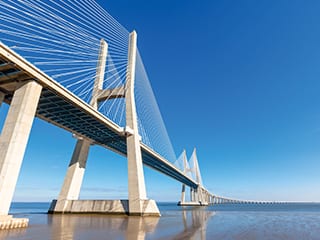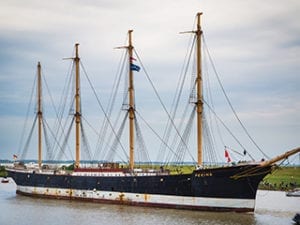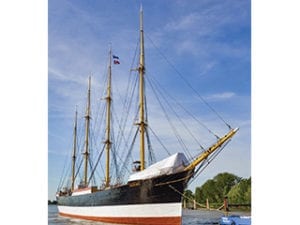The cart is empty!
Aberdeen Branch – Local Branch News
![]()
The January technical meeting featured a presentation by Joshua Owen (pictured left), Research Fellow in the Institute of Functional Surfaces, School of Mechanical Engineering, University of Leeds, on “Advanced once-through flow cell methodology for validation of a new ‘staged’ inhibition approach for matrix acidising treatments” as part of a collaboration between Schlumberger and Leeds to evaluate staged inhibitor approaches prior to industrial application.
Schlumberger recently introduced and patented a new staged acid corrosion inhibitor (ACI) treatment concept for application in matrix acidising treatments. The staged treatment concept recognises that treatments which employ a fixed dosage of corrosion inhibitor may not be optimal in terms of their efficiency. The concept proposes staged pumping of a first fluid composition designed to establish a persistent inhibitor film (Stage 1) and a second fluid composition to maintain the film and its associated inhibited corrosion rate (Stage 2). The staged ACI concept has the potential to provide enhanced corrosion protection of wellbore casing and coiled tubing (CT) materials, whilst using the same total quantity of inhibitor compared to conventional treatments.
![]()
Typical Onshore Well Acidising Treatment.
Typically, the corrosion test methods used to evaluate this approach have involved preparing two equivalent pre-heated and conditioned glass reactors, one of which is used for the first film-forming stage and the other for the second film maintenance stage. This procedure is rather inconvenient and involves a short period of time (~1 min) during which the weight loss coupons or working electrode (a rotating cylinder electrode) are in contact with the atmosphere which could change the corrosion potential and could potentially have an influence on the inhibitor film formed during the first stage. Instead, a bespoke, electrochemical, milli-fluidic once-through flow cell was used for validation of the staged ACI concept by exposing a carbon steel coupon, mounted within the flow cell, to 4 M hydrochloric acid (HCl) flow at a temperature of 80 °C and a flow rate of 5 ml/min. A once-through flow cell enables testing in a continuously flowing environment whilst maintaining a fresh acid solution, a controllable supply of inhibitor, and eliminating any contact of the electrode with the atmosphere.
The system was used to quantify changes in corrosion behaviour during continuous flow and during transitions from the first to second stage inhibitor dosages, to find optimal inhibitor concentration for film-forming and film maintenance stages, and to investigate the effect of metal pre-corrosion on inhibitor performance for carbon steel used as wellbore casing and CT materials. In situ linear polarisation resistance measurements confirmed that an acetylenic alcohol-based polymerisable inhibitor, used at a concentration of 0.01 wt.% in Stage 2 after a 0.2 wt.% concentration film forming stage (Stage 1), maintained excellent corrosion protection of N80 (wellbore casing) and HS80 (CT) carbon steel, with corrosion rates of < 5 mm/year measured.
![]()
![]()
Significant corrosion rate reductions achieved with staged inhibition versus applied controls.
Advantages of the flow cell for application in ACI studies are:
1. Well-defined hydrodynamics: Consistent and predictable flow across metal surface once-through nature:
2. Fresh HCl and ACI are continuously replenished and flow into waste, maintaining consistency in experimental conditions throughout In situ electrochemical measurements:
3. Measurements of corrosion rate in real time seamless condition changes:
4. Composition of fluid can be easily changed prior to inflow during an experiment (no exposure of coupon to air)
For the February presentation, Leo Richards, Principal Engineer and Andrew Duncan, Lead Consultant, both with Intertek Production and Integrity Assurance Group, described the “Implementation of Plan-Do-Check-Act review.
![]()
Leo Richards (left) Intertek Principal Engineer Production Chemistry and Andrew Duncan (right) Intertek Lead Consultant, Production and Integrity Assurance.
Corrosion management guidelines were used as the basis for an audit study of a large onshore oil field, the purpose of which was to perform a detailed review of the corrosion monitoring and mitigation systems, and to advise on any required upgrades to ensure world class/excellent asset integrity performance.
The approach taken for the study was to follow the UK Health and Safety Executive’s guidance for ‘Managing Health and Safety’, HSG65 (2013), of PLAN-DO-CHECK-ACT, which considers both Technical and Systems approaches associated with managing assets safely. This is a closed loop planetary model commencing with a high-level corporate policy for health and safety, under which there is a policy and plan for managing corrosion and integrity. The model ends with lessons learned which feed back into the corrosion and integrity policy and plan to ensure risks are managed to ‘As Low as Reasonably Practicable’.
The model ends with lessons learned which feed back into the corrosion and integrity policy and plan to ensure risks are managed to ‘As Low as Reasonably Practicable’.
First, a detailed study was carried out to assess and identify the current corrosion management techniques being used and their effectiveness in the operator’s fields and process plants. The ‘gaps’ were identified within the assets, and corrosion management proposals and solutions were then provided to ensure world class asset integrity performance.
A desktop-based document review was conducted in the UK and also at the client’s offices. This was followed up by site surveys, which included visits to at least one plant of each of these facility types: gas station, degassing station, gas recycle plant, PWI stations, gas distribution stations and stripping plants.
In order to help delegate and spread some of the responsibilities for the study areas within the operator’s corrosion team, Intertek deployed RACI Charts: Responsible – Accountable – Consulted – Informed, which serves to provide structure to the corrosion team as a whole, defining who does which task and allowing the right people to do the right job and move on with it.
The study highlighted a distinct pattern in the working practices of the operator with virtually all sections of the corrosion management system being shown to have some form of PLAN and DO. However, the implementation of the CHECK and ACT stage was missing from almost all aspects.
Some Key Findings
1. Automation and use of a suitable database/Corrosion Management System makes the DO stage easier and quicker.
2. For CHECK and ACT – an automated system requires Specialist assessment, rather than total reliance on the CMS output. Automation may also result in complacency.
3. For CP monitoring, sensors need to be regularly calibrated, and the system checked to ensure full protection.
4. Data requires to be both CHECKED and reviewed.
5. ACT will have double impact – ACT on what the data has shown and ACT on how the data was gathered.
Future Application of P-D-C-A and Corrosion
Monitoring
The working world has changed dramatically over the last two years due to Covid and there has been a significant change in Engineers’ working patterns and methods of project study and delivery. This has also combined with a move towards remote and automated inspection and monitoring, however, the speakers were keen to stress that if the PLANNING Stage is not implemented correctly, then wholesale automation of integrity systems is not always helpful, as automated systems will follow ‘Garbage In Garbage Out’ scenarios, Specialist input is always required. (Editor: Readers should note that a longer technical article on this topic appears later in this issue of the magazine).
Both these very engaging presentations generated many questions from the audience that were expertly responded to by the speakers, and all Q&A write-ups may be found on the branch webpage.
Slides of technical papers for branch events, along with their respective Q&A’s can be found at, ICorr Aberdeen Branch (google.com) under Local Technical Programme, Aberdeen Branch – Institute of Corrosion (icorr.org). A library of event recordings may also be found at: ICorr Aberdeen – YouTube.
It is also with our great pleasure to announce that Rysco International Inc. based in Alberta, Canada, has become the latest new sponsor of the branch, as well as becoming a GOLD sustaining member of ICorr. The branch is very grateful to all its sponsors for their continued support.
Finally, the branch is very sad to report the recent passing of Carol Anne Powell BSc., FIMMM, a long-term consultant to both the Nickel Development Institute and the Copper Development Association.
She had written over 40 papers and publications and been a member of our Partner Organisation the Marine Corrosion Forum (MCF), since its inception. During the recent COVID-19 epidemic as we were moving increasingly towards Webinar formats in April 2020, Carol greatly assisted us with an excellent presentation to our ICorr/MCF membership entitled ‘An Overview of the Corrosion of Metals in Seawater. In her memory, we would respectfully direct you to: https://marinecorrosionforum.co.uk/free-webinar-30%2F04%2F2020
Aberdeen Branch call for papers – Technical Session 2022 – 2023
The Aberdeen branch would like to invite you (or a colleague) to give a presentation during their 2022/2023 session. The events normally are held at 6 pm on the last Tuesday of the month from September till May 2023, excluding December 2022.
Topics on pressure systems, pipelines, renewables and structural integrity management with regards to the material selection, production chemistry, welding, corrosion/microbiological control and monitoring, inspection techniques and data analytics, are acceptable. Past case studies, project experiences, and emerging technologies have proved popular and interesting to members, and are particularly welcome.
The attendees (members and non-members) include students, technicians, technologists, engineers, scientists, researchers, managers, company directors and other professionals from the oil and gas, power generation, manufacturing and renewables sectors. Subsequently we would publish a report of the presentation in Corrosion Management magazine, and also on the ICorr, and Aberdeen website pages, including the presentation slides and Q&A session write-up. A recording of the event (if conducted online) will be uploaded to our YouTube channel later.
If interested, please supply the following including, speaker’s name, role and company, short biography of the speaker(s) (~ 150 words) and the proposed presentation title and an abstract (400 words), to the ICorr Aberdeen Branch Chair, Hooman Takhtechian, via htakhtechian@oceaneering.com and please also copy in icorrabz@gmail.com in your submission.
All the submitted presentations will be subject to a branch committee review and those successful will be scheduled into the 2022/2023 events programme. Please note that the deadline of the submission is
30th April, and the branch will confirm the successful presenters in May, and announce them in June.




